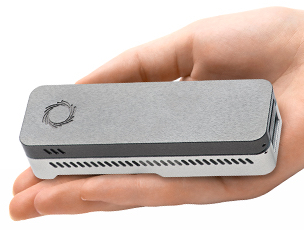First full genome of a living organism sequenced and assembled using smartphone-size device
June 15, 2015

MinION MkI genome sequencer (credit: Oxford Nanopore)
Researchers in Canada and the U.K. have sequenced and assembled de novo (from the ground up) the full genome of a living organism, the bacteria Escherichia Coli, using Oxford Nanopore’s MinION device, a genome sequencer that can fit in the palm of your hand.
The findings, published today in the journal Nature Methods, provide proof of concept for the new genome sequencer technology.
The researchers expect to use the device to sequence genomes in increasingly more complex organisms, eventually including humans, said Jared Simpson, PhD, Principal Investigator at the Ontario Institute for Cancer Research and a lead author on the study.
“While our work is a demonstration of the capabilities of the technology, the most significant advance is in the methods. We were able to mathematically model nanopore sequencing and develop ways to reconstruct complete genomes off this tiny sequencer,” he said.
Standard sequencing platforms can only do one of two things: generate vast amounts of data, or read long enough stretches of the genome to allow complete reconstruction. The Nanopore device has the potential to achieve both goals, according to Simpson. “Long reads are necessary to assemble the most repetitive parts of genomes but we need a lot of reads if we want to sequence human genomes. The small size of the MinION suggests there is room to scale up and sequence larger and more complex samples.”
A drawback of the technology is that the single reads it produces are currently much less accurate than the reads produced by larger devices, so strong bioinformatics tools are needed to correct errors. However, the new methods Simpson and colleagues have now developed are able to overcome the error rate and compute a more accurate final sequence.
The assembly method the authors devised has three stages. (1) Overlaps between sequence reads are detected and corrected using a multiple alignment process. (2) The corrected reads are assembled using the Celera assembler. (3) The assembly is refined using a probabilistic model of the electric signals caused by DNA moving through the nanopore.
According to Tom Hudson, PhD, President and Scientific Director of the Ontario Institute for Cancer Research, “Scaled up, this technology could one day be used to sequence tumor genomes. The device’s portable nature would allow for sequencing to become far more accessible, bringing the option of more personalized diagnosis and treatment to more patients.”
Nanopore DNA sequencing from Oxford Nanopore
MinION: a portable analysis device from Oxford Nanopore
Abstract of A complete bacterial genome assembled de novo using only nanopore sequencing data
We have assembled de novo the Escherichia coli K-12 MG1655 chromosome in a single 4.6-Mb contig using only nanopore data. Our method has three stages: (i) overlaps are detected between reads and then corrected by a multiple-alignment process; (ii) corrected reads are assembled using the Celera Assembler; and (iii) the assembly is polished using a probabilistic model of the signal-level data. The assembly reconstructs gene order and has 99.5% nucleotide identity.